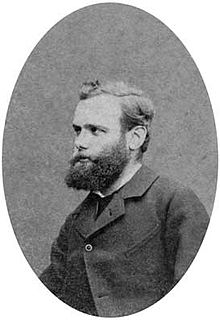Eugène Burnand
Charles Louis Eugène Burnand (born August 30, 1850 in Moudon , † February 4, 1921 in Paris ) was a Swiss painter and illustrator .
Life
Eugène Burnand was born in Moudon as the son of the arms manufacturer Edouard Burnand . The Burnand family made up the local elite in Moudon and were also influential in the canton of Vaud and at the national level. His father, who together with Joseph Prélat had invented a rifle named after him, owned the Neuhausen weapons factory founded in 1857, which later became the SIG Combibloc Group . Burnand mainly delivered to Italy and to the Swiss Army , of which he was chief of artillery weapons from 1870. Burnand's uncle was the military, national councilor , insurance contractor and banker ( Caisse d'épargne du district de Moudon ) Charles Burnand .
Eugène Burnand attended schools in Schaffhausen and studied architecture at the ETH in Zurich from 1868–1871 , then he took painting lessons from 1872 with Barthélemy Menn in Geneva and around 1876 with Jean-Léon Gérôme in Paris . In nearby Versailles , where he lived from 1878 to 1884, he learned various printmaking techniques from Paul Girardet , such as etching and copper engraving , and in 1878 married his daughter Julie Antonine Girardet. Burnand stayed in Rome from 1876 to 1877 , at the same time he worked on the Paris weekly magazine L'Illustration until around 1896 . Burnand also worked as a book illustrator; For example, he illustrated Mireille by Frédéric Mistral , Contes du Lundi by Alphonse Daudet , and Légend des Alpes vaudoises by Alfred Cérésole . The Salon de Paris presented him with awards for engraving and painting in 1882 and 1883 . He was awarded gold medals at the Paris World's Fair in 1889 and 1900.
His father died in December 1892, which further secured him financially. In 1893 he moved to Montpellier in the south of France and was made Knight of the Legion of Honor that same year . From 1895 his painting turned increasingly to religious themes. From 1903 to 1907 he lived in Hauterive near Neuchâtel and then moved his main residence again to Paris. In 1909 the Swiss National Bank commissioned him to design the 500 and 1000 franc notes. He also designed a depiction of the Sermon on the Mount on the choir windows of the Reformed Church of Herzogenbuchsee from 1912 and a now-lost panorama of the Virgin , which was created in collaboration with Auguste Baud-Bovy and François Furet for the World Exhibition in Chicago and the Swiss National Exhibition of 1896 originated in Geneva . During the First World War, Burnand resided at the family's country estate in Sépey in the canton of Vaud and devoted himself to landscape painting , his main work, Labor dans le Jorat . After the end of the war, he was again able to settle in Paris, where he died in 1921. In 1922 a collection of pastel portraits of soldiers, entitled Les alliés de la guerre des nations, was published posthumously in print. His hometown Moudon dedicated a museum to him in the old manor house. In several of Burnand's formerly private living rooms, it shows mostly large-format paintings, including rural genre scenes , works of Christian iconography and history painting .
literature
- William Hauptman: Burnand, Eugène. In: Historical Lexicon of Switzerland .
- Friedrich Wilhelm Bautz : BURNAND, Eugène. In: Biographisch-Bibliographisches Kirchenlexikon (BBKL). Volume 1, Bautz, Hamm 1975. 2nd, unchanged edition Hamm 1990, ISBN 3-88309-013-1 , Sp. 823-824.
- Eugène Burnand: Ten colored art sheets . With an introductory text by Dr. Theol. David Koch. Verlag für Volkskunst, Richard Keutel, Stuttgart, around 1900.
Web links
- Patrick Schaefer: Burnand, Charles-Louis-Eugène. In: Sikart
- Publications by and about Eugène Burnand in the Helveticat catalog of the Swiss National Library
- Literature by and about Eugène Burnand in the catalog of the German National Library
- Musée Eugène Burnand in Moudon (French)
Individual evidence
- ↑ a b c Gilbert Marion, translated by Elmar Meier: Edouard Burnand. In: Historical Lexicon of Switzerland. May 5, 2004, accessed December 30, 2019 .
- ^ Sabine Carruzzo-Frey, translated by Anja Lindner: Charles Burnand. In: Historical Lexicon of Switzerland. November 3, 2004, accessed December 30, 2019 .
- ↑ a b c Patrick Schaefer, et al .: From Anker to Zünd - Art in the Young Federal State 1848–1900 . Ed .: Christian Klemm. Scheidegger & Spiess / Kunsthaus Zürich, Zürich 1998, ISBN 3-906574-00-8 , p. 395 .
- ↑ a b c d William Hauptman, translated by Kerstin Martinez Griese: Eugène Burnand. In: Historical Lexicon of Switzerland. November 3, 2004, accessed December 30, 2019 .
| personal data | |
|---|---|
| SURNAME | Burnand, Eugène |
| BRIEF DESCRIPTION | Swiss painter |
| DATE OF BIRTH | August 30, 1850 |
| PLACE OF BIRTH | Moudon |
| DATE OF DEATH | February 4, 1921 |
| Place of death | Paris |





